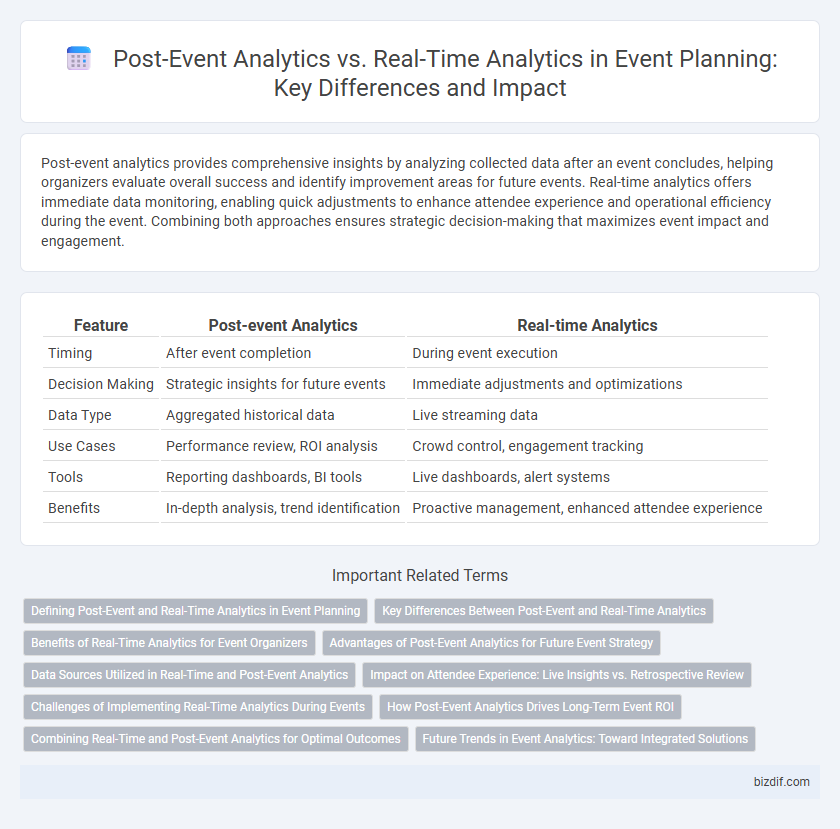Post-event analytics provides comprehensive insights by analyzing collected data after an event concludes, helping organizers evaluate overall success and identify improvement areas for future events. Real-time analytics offers immediate data monitoring, enabling quick adjustments to enhance attendee experience and operational efficiency during the event. Combining both approaches ensures strategic decision-making that maximizes event impact and engagement.
Table of Comparison
| Feature | Post-event Analytics | Real-time Analytics |
|---|---|---|
| Timing | After event completion | During event execution |
| Decision Making | Strategic insights for future events | Immediate adjustments and optimizations |
| Data Type | Aggregated historical data | Live streaming data |
| Use Cases | Performance review, ROI analysis | Crowd control, engagement tracking |
| Tools | Reporting dashboards, BI tools | Live dashboards, alert systems |
| Benefits | In-depth analysis, trend identification | Proactive management, enhanced attendee experience |
Defining Post-Event and Real-Time Analytics in Event Planning
Post-event analytics in event planning involves collecting and analyzing data after the event concludes to evaluate attendee engagement, satisfaction, and overall success metrics. Real-time analytics processes data as the event unfolds, enabling planners to make immediate adjustments to improve audience experience and operational efficiency. Both analytics types leverage tools like attendee tracking, social media monitoring, and feedback surveys but differ in timing and actionable insight delivery.
Key Differences Between Post-Event and Real-Time Analytics
Post-event analytics involves analyzing data collected after an event to measure overall success, identify trends, and generate comprehensive reports, focusing on metrics like attendee satisfaction and ROI. Real-time analytics provides immediate insights during an event, enabling organizers to make quick decisions based on live data such as attendee engagement, session popularity, and technical issues. The key differences lie in timing--post-event is retrospective with in-depth analysis, while real-time is proactive, facilitating instant adjustments and enhanced attendee experiences.
Benefits of Real-Time Analytics for Event Organizers
Real-time analytics empower event organizers to make immediate data-driven decisions, enhancing attendee engagement and operational efficiency during the event. This continuous flow of insights allows for instant adjustments to logistics, content delivery, and audience interaction, resulting in a more dynamic and responsive event experience. Leveraging real-time data reduces risks and maximizes ROI by swiftly addressing issues and capitalizing on emerging opportunities.
Advantages of Post-Event Analytics for Future Event Strategy
Post-event analytics provides detailed insights by aggregating comprehensive data from attendance, engagement metrics, and feedback, enabling event planners to identify trends and areas for improvement. It allows for in-depth evaluation of overall event success, helping refine marketing strategies, budget allocation, and content planning for future events. Leveraging historical data through post-event analysis enhances decision-making accuracy and optimizes resource management in subsequent event planning cycles.
Data Sources Utilized in Real-Time and Post-Event Analytics
Real-time analytics in event planning sources data from live attendee interactions, social media feeds, sensor inputs, and streaming video to provide immediate insights for dynamic decision-making. Post-event analytics aggregates data from registration databases, survey responses, transaction logs, and session recordings to evaluate overall event performance and attendee satisfaction. Leveraging both data sources enables comprehensive analysis, combining instant feedback with in-depth post-event metrics to optimize future event strategies.
Impact on Attendee Experience: Live Insights vs. Retrospective Review
Real-time analytics in event planning enhance the attendee experience by providing live insights that allow organizers to immediately address issues, personalize interactions, and boost engagement during the event. Post-event analytics offer a comprehensive retrospective review, enabling detailed assessment of attendee behavior, satisfaction, and overall event success to inform future improvements. Leveraging both approaches maximizes understanding of attendee preferences and elevates the quality of subsequent events.
Challenges of Implementing Real-Time Analytics During Events
Implementing real-time analytics during events faces challenges such as data latency, where rapid data processing and transmission are crucial for timely insights. Integrating diverse data sources from multiple event touchpoints requires advanced infrastructure and seamless interoperability to avoid information silos. Furthermore, the need for scalable cloud solutions and robust cybersecurity measures complicates real-time analytics deployment in dynamic event environments.
How Post-Event Analytics Drives Long-Term Event ROI
Post-event analytics aggregates attendee behavior, engagement metrics, and feedback to uncover actionable insights that improve future event strategies, boosting long-term ROI. By analyzing data trends and conversion rates after the event, planners can optimize marketing efforts and resource allocation for subsequent events. This comprehensive review informs data-driven decisions that increase sponsor value, enhance attendee satisfaction, and maximize revenue growth over time.
Combining Real-Time and Post-Event Analytics for Optimal Outcomes
Combining real-time analytics with post-event analytics enables event planners to make immediate data-driven decisions while also gaining comprehensive insights for future improvements. Real-time analytics provides actionable information during the event, such as attendee engagement and resource utilization, whereas post-event analytics offers detailed performance metrics and ROI evaluations. Integrating both approaches maximizes event success by optimizing on-the-spot adjustments and strategic planning based on complete data analysis.
Future Trends in Event Analytics: Toward Integrated Solutions
Post-event analytics offers comprehensive insights by aggregating data for detailed evaluation, while real-time analytics provides immediate feedback to optimize event flow and attendee engagement. Emerging trends in event analytics emphasize integrating both approaches through AI-powered platforms to deliver seamless, actionable intelligence throughout the event lifecycle. Future solutions focus on unified dashboards combining predictive modeling and live data streams to enhance decision-making and personalize attendee experiences.
Post-event analytics vs Real-time analytics Infographic

 bizdif.com
bizdif.com